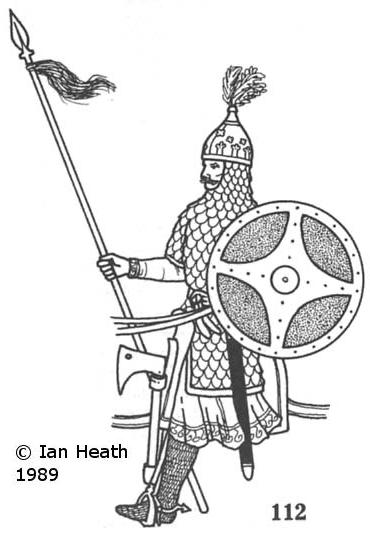
POLISH KNIGHT, 11th-12th CENTURIES
An extract from Armies of Feudal Europe 1066-1300by Ian Heath

112. POLISH KNIGHT, 11th-12th CENTURIES
In the 11th century mounted Polish soldiers were called druzynnik, but during the 12th century this term was generally replaced by rycerz, derived from Ritter, the German word for ‘knight’. At this date their equipment was still predominantly of native Polish design and manufacture, though some was already being imported from Germany and Denmark. Scale was the most commonly worn form of armour, with or without a coif. Lamellar corselets imported from Russia also sometimes appear but were not particularly popular, while leather corselets with studs or rings stitched on were another alternative (for which see figure 120). Mail seems to have been uncommon in Poland until the mid- to late-12th century and was thus more valuable than in the West, being at first generally worn only by kings and nobles. This figure actually wears mail hosen, but others substituted scale or else wore no armour on the legs at all. Helmets were fairly elaborate affairs, made of iron or even bronze and often decorated with gold and silver inlay (as too were their spurs). Some had mail aventails and most had coloured plumes of horsehair or feathers. Bohemian and Russian helmets of similar design were also worn, these usually having nasals.
His wooden shield is about 30" in diameter, reinforced with iron and with a boss that was often spiked. Where visible the wooden parts of the orb were painted, most often red. Being fairly heavy and apparently not fitted with a guige-strap, the shield was usually hung from the saddle when not in use. Kite-shields also came into widespread use during the 12th century, but these were generally smaller and more rounded than those of Western Europe and are consequently usually referred to as ‘almond’ shields. They were replaced in turn by the typical flat-topped Western European ‘heater’ shield during the first half of the 13th century. Arms consisted of a sword in a red, green or yellow sheath, a lance of about 8 feet and usually an axe. The lance sometimes had a horse-tail (bunchuk) attached as here, thought to be an indication of senior rank, others having a red pennon (bearing a family badge in the case of princes). The axe was suspended from the saddle, a thong through a hole punched in the blade often securing it, with the butt resting in a frog. The use of the axe had been generally, though not completely, abandoned by the late-12th century.